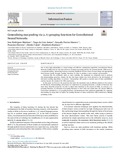Mostrar el registro sencillo del ítem
Generalizing max pooling via (a, b)-grouping functions for convolutional neural networks
| dc.creator | Rodríguez Martínez, Iosu | es_ES |
| dc.creator | Asmus, Tiago | es_ES |
| dc.creator | Pereira Dimuro, Graçaliz | es_ES |
| dc.creator | Herrera, Francisco | es_ES |
| dc.creator | Takáč, Zdenko | es_ES |
| dc.creator | Bustince Sola, Humberto | es_ES |
| dc.date.accessioned | 2023-09-19T07:23:41Z | |
| dc.date.available | 2023-09-19T07:23:41Z | |
| dc.date.issued | 2023 | |
| dc.identifier.citation | Rodríguez-Corbo, F. A., Celaya-Echarri, M., Shubair, R. M., Falcone, F., & Azpilicueta, L. (2023). An enhanced approach to virtually increase quasi-stationarity regions within geometric channel models for vehicular communications. IEEE Antennas and Wireless Propagation Letters, 22(9), 2180-2184. https://doi.org/10.1109/LAWP.2023.3281081 | en |
| dc.identifier.issn | 1566-2535 | |
| dc.identifier.uri | https://hdl.handle.net/2454/46368 | |
| dc.description.abstract | Due to their high adaptability to varied settings and effective optimization algorithm, Convolutional Neural Networks (CNNs) have set the state-of-the-art on image processing jobs for the previous decade. CNNs work in a sequential fashion, alternating between extracting significant features from an input image and aggregating these features locally through ‘‘pooling" functions, in order to produce a more compact representation. Functions like the arithmetic mean or, more typically, the maximum are commonly used to perform this downsampling operation. Despite the fact that many studies have been devoted to the development of alternative pooling algorithms, in practice, ‘‘max-pooling" still equals or exceeds most of these possibilities, and has become the standard for CNN construction. In this paper we focus on the properties that make the maximum such an efficient solution in the context of CNN feature downsampling and propose its replacement by grouping functions, a family of functions that share those desirable properties. In order to adapt these functions to the context of CNNs, we present (𝑎��, 𝑏��)- grouping functions, an extension of grouping functions to work with real valued data. We present different construction methods for (𝑎, 𝑏)-grouping functions, and demonstrate their empirical applicability for replacing max-pooling by using them to replace the pooling function of many well-known CNN architectures, finding promising results. | en |
| dc.description.sponsorship | The authors gratefully acknowledge the financial support of Tracasa Instrumental (iTRACASA) and of the Gobierno de Navarra - Departamento de Universidad, Innovación y Transformación Digital, as well as that of the Spanish Ministry of Science (project PID2019-108392GB-I00 (AEI/10.13039/501100011033)) and the project PC095-096 FUSIPROD. T. Asmus and G.P. Dimuro are supported by the projects CNPq (301618/2019-4) and FAPERGS (19/2551-0001279-9). F. Herrera is supported by the Andalusian Excellence project P18-FR4961. Z. Takáč is supported by grant VEGA 1/0267/21. Open access funding provided by Universidad Pública de Navarra. | en |
| dc.format.mimetype | application/pdf | en |
| dc.language.iso | eng | en |
| dc.publisher | Elsevier | en |
| dc.relation.ispartof | Information Fusion 99 (2023) 101893 | en |
| dc.rights | © 2023 The Author(s). This is an open access article under the CC BY license. | en |
| dc.rights.uri | http://creativecommons.org/licenses/by/4.0/ | |
| dc.subject | Convolutional neural networks | en |
| dc.subject | Grouping functions | en |
| dc.subject | Pooling functions | en |
| dc.subject | Image classification | en |
| dc.title | Generalizing max pooling via (a, b)-grouping functions for convolutional neural networks | en |
| dc.type | Artículo / Artikulua | es |
| dc.type | info:eu-repo/semantics/article | en |
| dc.date.updated | 2023-09-19T06:40:08Z | |
| dc.contributor.department | Estadística, Informática y Matemáticas | es_ES |
| dc.contributor.department | Estatistika, Informatika eta Matematika | eu |
| dc.contributor.department | Institute of Smart Cities - ISC | es |
| dc.rights.accessRights | Acceso abierto / Sarbide irekia | es |
| dc.rights.accessRights | info:eu-repo/semantics/openAccess | en |
| dc.identifier.doi | 10.1016/j.inffus.2023.101893 | |
| dc.relation.projectID | info:eu-repo/grantAgreement/AEI/Plan Estatal de Investigación Científica y Técnica y de Innovación 2017-2020/PID2019-108392GB-I00/ES/ | en |
| dc.relation.projectID | info:eu-repo/grantAgreement/Gobierno de Navarra | en |
| dc.relation.publisherversion | https://doi.org/10.1016/j.inffus.2023.101893 | |
| dc.type.version | Versión publicada / Argitaratu den bertsioa | es |
| dc.type.version | info:eu-repo/semantics/publishedVersion | en |
| dc.contributor.funder | Universidad Pública de Navarra / Nafarroako Unibertsitate Publikoa | es |



